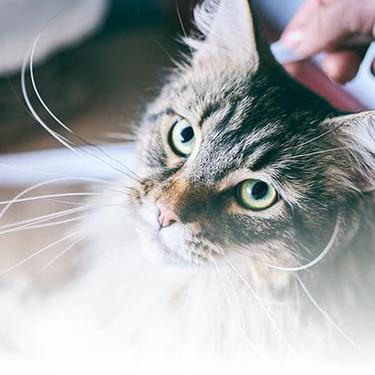
-
Find the right food for your petTake this quiz to see which food may be the best for your furry friend.Find the right food for your petTake this quiz to see which food may be the best for your furry friend.Featured products
 Adult Wet Dog Food with Beef
Adult Wet Dog Food with BeefHill's Science Plan Adult Multipack Wet Dog Food with Chicken, Beef & Turkey are complete premium pet foods for adult dogs from 1 year. Your dog will love these deliciously smooth and savoury minced loaves, formulated for balanced nutrition and overall health.
Shop Now Puppy Food
Puppy FoodHill's Science Plan Puppy Multipack Wet Dog Food with Chicken & Beef are complete premium pet foods for growing puppies from weaning until 1 year old and for pregnant and nursing dogs. Your puppy will love these deliciously smooth and savoury minced loaves, formulated for balanced nutrition and overall health.
Shop Now Mature Adult Dog Food
Mature Adult Dog FoodHill's Science Plan Mature Adult Multipack Wet Dog Food with Chicken & Beef are complete premium pet foods for mature adult dogs from 7 years. Your dog will love these deliciously smooth and savoury minced loaves, formulated to deliver the appropriate amount of energy to support the needs of adult dogs.
Shop NowFeatured products Light Adult Multipack Wet Cat Food with Chicken & Ocean Fish
Light Adult Multipack Wet Cat Food with Chicken & Ocean FishTender chicken chunks in gravy for cats, with L-carnitine and fewer calories for ideal weight management. Packed with high-quality protein, omega-6s, and vitamin E for shiny fur and healthy skin.
Shop Now Mature Adult Wet Cat Food with Chicken
Mature Adult Wet Cat Food with Chicken
Tender chicken chunks in gravy for mature adult cats. Made with easy-to-digest ingredients, high-quality protein for lean muscle maintenance and antioxidant vitamins C+E for optimal health.
Shop Now Adult Multipack Wet Cat Food with Beef, Ocean Fish & Chicken
Adult Multipack Wet Cat Food with Beef, Ocean Fish & ChickenTender chunks in gravy for cats, with high-quality protein to maintain lean muscle. With vitamin E and omega-3s & -6s for healthy skin and balanced minerals to support healthy vital organs.
Shop Now -
Dog
- Dog Tips & Articles
-
Health Category
- Weight
- Food & Environmental Sensitivities
- Urinary
- Digestive
- Joint
- Kidney
-
Life Stage
- Puppy Nutrition
- Adult Nutrition
- Senior Nutrition
Cat- Cat Tips & Articles
-
Health Category
- Weight
- Skin & Food Sensitivities
- Urinary
- Digestive
- Kidney
-
Life Stage
- Kitten Nutrition
- Adult Nutrition
Featured articles The Incredible Science Behind Your Pet's Microbiome
The Incredible Science Behind Your Pet's MicrobiomeLearn what your pet's microbiome is, how it contributes to your pet's gut and overall health, and why nutrition is important in maintaining healthy microbiomes.
Read More Show some love with wet foods: a great choice for pets with health issues
Show some love with wet foods: a great choice for pets with health issuesShow some love with wet foods: a great choice for pets with health issues.
Read More The Right Diet For Your Pet
The Right Diet For Your PetIn people, the right diet is very important. If you are eating the wrong way for your metabolism, activity level, age and lifestyle you could end up with health issues.
Read More -


If you've noticed your cat has been scratching more than normal, they could be hosting tiny parasites known as cat fleas. You may wonder how your cat became infested and how you get rid of fleas. Read on for the answer to those questions and more about cat fleas.
How Did My Cat Get Fleas?
According to the British Pest Control Association, fleas can jump more than 100 times their own body length. Some have even been found to jump 200 times their length! These jumping skills help these non-flying parasites to travel easily from the ground to a new host, or from host to host.
Animals commonly found in your back garden — such as foxes, mice, squirrels and others — more than likely carry fleas, the type of which will vary between the different species. They can leave behind fleas or larvae in your garden, and some of those fleas could potentially enter your home by hitch-hiking on you or a pet coming in from outdoors. Fleas can easily jump between cats and dogs alike, no matter the species.
Your cat could even simply have attracted a flea by sitting peacefully in front of their favourite window.

How to Identify Fleas on Your Cat
Just a couple of fleas (female and male) can turn into a major infestation in a short time, as a single female can lay up to fifty eggs a day, according to the RSPCA. The most obvious sign of a flea infestation is a cat obsessively scratching their body or appearing to nibble at their skin. The PDSA says that you might also notice:
- Bald patches or rough/spiky fur.
- Sore or irritated skin.
- Rashes or bites.
If you suspect your cat has fleas, run a fine-tooth comb through their coat while they stand on a white piece of paper or a white towel. If they do have fleas, you'll more than likely dislodge tiny black specks (flea faeces), which turn red if you moisten the paper. You can see fleas with the naked eye, so you may even be able to easily spot a few fleas on the white background.


Tasty Tips
What Health Problems Do Fleas Cause?
Cat fleas can be more than an irritant; sometimes they can be the cause of other serious health issues. For instance, fleas may transmit tapeworms. If your cat is still a lightweight kitten or the flea burden is high, bloodsucking from fleas could potentially also lead to anaemia.
Treating and Preventing Fleas
Ready to put the "no vacancy" sign out for these tiny freeloaders? Your first course of action is to call your vet to get advice and treatment options. Your vet might also suggest having your cat tested for tapeworms and other diseases.
Not only do you have to treat your cat, you also have to remove all pests from your property with careful vacuuming and washing to prevent reinfestation. Your vet can recommend how to treat your home to effectively rid it of all pests.
You can prevent fleas from coming back by using one of the proven flea and tick repellent products on the market, even on indoor cats. The PDSA recommends using a prescription product from your veterinarian, warning that other products bought “off the shelf” in supermarkets or pet stores often contain less effective ingredients. They also warn against using dog flea treatments or household flea sprays on cats.
Your vet will likely recommend treating your cat throughout the entire year. Depending on the country you live in, fleas can be a serious problem all year round (the Mediterranean region and African countries, for example), a summer-only problem (milder climates) or no problem at all (Northern Nordic areas). It is important to realise that due to global warming, fleas are becoming happier and happier. You may think you have the cleanest cat in the world, but fleas can affect any pet. So keep a watchful eye to make sure your cat is happy, healthy and itch-free.


Kara Murphy is a freelance writer and pet parent who lives in Erie, Pa. She has a goldendoodle named Maddie.
Related products


Tender chicken chunks in gravy for mature adult cats. Made with easy-to-digest ingredients, high-quality protein for lean muscle maintenance and antioxidant vitamins C+E for optimal health.

Tender chicken chunks in gravy for cats, with L-carnitine and fewer calories for ideal weight management. Packed with high-quality protein, omega-6s, and vitamin E for shiny fur and healthy skin.

Tender chunks in gravy for cats, with high-quality protein to maintain lean muscle. With vitamin E and omega-3s & -6s for healthy skin and balanced minerals to support healthy vital organs.
Related articles

From essential vitamins & minerals to different types of meat, learn what to look for when choosing the best cat food for your feline.

Chocolate is known to be poisonous for dogs, but it can also be toxic for cats. Learn why chocolate is bad for cats & what to do if she's eaten it.

Learn how to make homemade cat treats that are healthy for your pet with this recipe from Hills Pet Nutrition.

There are three common ways to feed a cat. Each way has its advantages and disadvantages.

Put your cat on a diet without them knowing
Our low calorie formula helps you control your cat's weight. It's packed with high-quality protein for building lean muscles, and made with purposeful ingredients for a flavourful, nutritious meal. Clinically proven antioxidants, Vitamin C+E, help promote a healthy immune system.
Put your cat on a diet without them knowing
Our low calorie formula helps you control your cat's weight. It's packed with high-quality protein for building lean muscles, and made with purposeful ingredients for a flavourful, nutritious meal. Clinically proven antioxidants, Vitamin C+E, help promote a healthy immune system.

